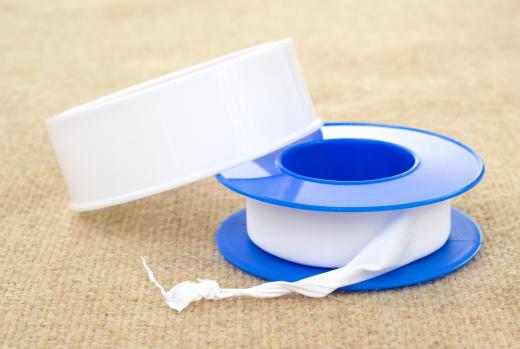Thread seal tape is a plumbing product that can be used to make a tight seal with plumbing fittings. Simply screwing threaded fittings together will not create the best possible seal and can leave some leaks. Adding thread seal tape will allow the seal to become as tight and even as possible. It is important to use the right amount, as too much can create a loose fitting.
This tape is typically white and made from Teflon. It may also be known as Teflon tape or PTFE tape, depending on regional slang. To use it, plumbers pull off a length, cut it, and wrap it around the external threads of a pipe, pulling it tight so it settles into the grooves between threads. They then screw the other component on. The tape lubricates the fittings so they fit tightly and neatly together, creating a very tight seal.

Thread seal tape can be used on any system where there will be pressure, and leaks are a potential problem. Water, propane gas, and oxygen plumbing systems all need tape to seal properly. After applying the tape and making sure all the fittings are fastened, the plumber can carefully test the system to check for leaks and adjust any of the fittings, if necessary. Sometimes an extra layer of thread seal tape needs to be removed, or more tape needs to be added to a fitting with an inadequate seal.
Color-coded products are available from some manufacturers for people who want tapes in different colors. Green, red, and yellow are common options, and it may be possible to order custom colors or patterns if people need a lot of tape in a particular color. When color coding is used, it is important to be consistent so someone else working on the plumbing will understand the logic the last plumber used during installation or repair.
The alternative to thread seal tape is pipe dope, a paste people can spread on the threads to serve a similar function. Tape is cleaner and easier to work with, and many plumbers prefer it. In some applications, it may be necessary to use both. Employees at a plumbing supply store can help customers determine which product would be most suitable for their needs. Plumbers usually learn which option suits given applications through experience and mentoring from other plumbing professionals. The building code can also play a role in deciding how to handle plumbing problems, as it sometimes specifies particular methods for safety reasons.
Ever since she began contributing to the site several years ago, Mary has embraced the exciting challenge of being a About Mechanics researcher and writer. Mary has a liberal arts degree from Goddard College and spends her free time reading, cooking, and exploring the great outdoors.

